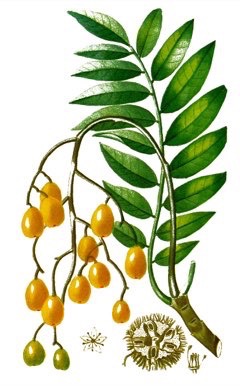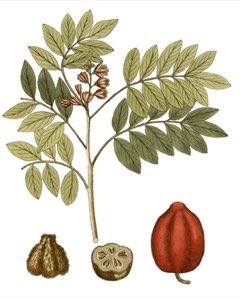 |
|
http://www.edibleplants.org |
 |
| http://www.edibleplants.org |
Translate this page:
Summary
Purple Mombin, Spondias purpurea, is a deciduous tree commonly found in western part of South America. It has a spreading crown and it reaches a height of up to 25 m upon maturity. Its bole can be 30 - 80 cm in diameter. The leaves are pinnate with 7 to 23 leaflets each leaf. The flowers are small, reddish-purple, and produced in large panicles. The fruits are yellow or purplish-red and are oval drupe. Ripe fruits can be consumed raw or cooked with sugar to make desserts. Unripe fruits, on the other hand, can be pickled or made into a tart green sauce. Young shoots and leaves are often eaten raw but can also be cooked. The seeds are edible as well. Medicinally, the leaves have antibacterial properties. It can be made into juice and used as treatment of swollen glands and trauma. It can also be crushed and used as poultice for headaches. The fruits are laxative and used for constipation. Other plant parts are used for dysentery, diarrhea, and sore throat. Wood ashes are used in soap making. The wood is soft, light in weight, and not durable but can be used for paper pulp production.
Physical Characteristics

 Spondias purpurea is a deciduous Tree growing to 10 m (32ft) by 10 m (32ft) at a fast rate.
Spondias purpurea is a deciduous Tree growing to 10 m (32ft) by 10 m (32ft) at a fast rate.
See above for USDA hardiness. It is hardy to UK zone 10.
Suitable for: medium (loamy) and heavy (clay) soils, prefers well-drained soil and can grow in heavy clay soil. Suitable pH: mildly acid, neutral and basic (mildly alkaline) soils and can grow in very acid soils.
It cannot grow in the shade. It prefers dry or moist soil.
UK Hardiness Map
US Hardiness Map
Synonyms
Plant Habitats
Edible Uses
Edible Parts: Fruit Leaves Seed Shoots
Edible Uses: Gum
Fruit - raw or cooked[46 ]. Spicy and subacid, the juicy yellow pulp is said to have a flavour resembling a plum[303 ]. It is eaten raw or cooked with sugar[301 , 303 ]. Usually eaten ripe and raw, though children, and even some adults, eat the sour, green fruits[331 ]. It is also used for making jams, ice cream etc[301 ]. Unripe fruits are pickled or made into a tart green sauce[301 ]. The yellow or purplish-red cylindrical fruits are 25 - 30mm long[303 ]. The young shoots and leaves often are conspicuously coloured with red and purple[303 ]. They have a rather agreeable acid flavour, and often are eaten raw by children or adults[331 ]. They can also be cooked[301 ]. The leaves contain 5.5% protein[303 ]. Edible seeds[303 ].
References More on Edible Uses
Medicinal Uses
Plants For A Future can not take any responsibility for any adverse effects from the use of plants. Always seek advice from a professional before using a plant medicinally.
Antibacterial Antidiarrhoeal Dysentery Laxative Poultice
The leaves exhibit anti-bacterial properties[303 ]. The leaf juice is taken orally in the treatment of swollen glands and trauma[303 ]. The crushed leaves are applied as a poultice to treat headaches[303 ]. In large amounts the fruit is laxative and is used as a treatment for constipation[303 ] The plant is also used to treat dysentery and diarrhoea, whilst parts of the plant are used in the preparation of a herbal remedy for sore throat[303 ].
References More on Medicinal Uses
The Bookshop: Edible Plant Books
Our Latest books on Perennial Plants For Food Forests and Permaculture Gardens in paperback or digital formats.

Edible Tropical Plants
Food Forest Plants for Hotter Conditions: 250+ Plants For Tropical Food Forests & Permaculture Gardens.
More

Edible Temperate Plants
Plants for Your Food Forest: 500 Plants for Temperate Food Forests & Permaculture Gardens.
More

More Books
PFAF have eight books available in paperback and digital formats. Browse the shop for more information.
Shop Now
Other Uses
Cosmetic Fencing Fuel Gum Paper Soap making Wood
Agroforestry Uses: They often are planted for living fence posts, being one of the best of all trees for the purpose in the tierra caliente[331 ]. Even quite large limbs when cut and set in the ground take root quickly, and often are set thickly to form immediate barriers[331 , 418 ]. Other Uses In some regions the ashes of the wood are used in soap-making[331 , 447 ]. Some cosmetic and hygienic products eg soap are manufactured from parts of this tree[303 ]. The seeds have a thick gum coating commonly used in chilli stews. This gum has good solubility in water and on hydrolysis yields polysaccharides. Aspartic acid and valine are its major amino acid constituents[303 ]. The whitish wood is soft, light in weight and brittle[447 ]. It is said to have been used in Brazil for paper pulp[331 ]. The easily cut and brittle branches are potential fuel wood[303 ].
Special Uses
Food Forest
References More on Other Uses
Cultivation details
The plant grows best in the subhumid and frost-free tropics at an elevation up to 2,000 metres[200 , 303 , 418 ]. It grows best in areas where annual daytime temperatures are within the range 22 - 28°c, but can tolerate 13 - 35°c[418 ]. The plant is not frost tolerant. It prefers a mean annual rainfall in the range 800 - 1,100mm, but tolerates 600 - 1,800mm[418 ]. For good fruit set it requires growing conditions with a marked dry season of up to 6 months[303 ]. Requires a sunny position[418 ]. Plants are not too fussy over soil, so long as it is well-drained. It does not need very fertile conditions, however very poor soil, or shallow land, is unsuitable[200 ]. Prefers a pH in the range 6 - 7, tolerating 5.5 - 8[418 ]. Seedling plants can start producing fruit when about 4 - 5 years old, whilst cuttings can commence when 2 - 3 years old[335 ]. Fruits can be obtained in Guatemala at almost any season of the year[331 ]. Several named forms have been developed in Guatemala[331 ]. Flowering Time: Late Winter/Early Spring Mid Spring Late Spring/Early Summer. Bloom Color: White/Near White Cream/Tan.
References Carbon Farming Information and Carbon Sequestration Information
Temperature Converter
Type a value in the Celsius field to convert the value to Fahrenheit:
Fahrenheit:
The PFAF Bookshop
Plants For A Future have a number of books available in paperback and digital form. Book titles include Edible Plants, Edible Perennials, Edible Trees,Edible Shrubs, Woodland Gardening, and Temperate Food Forest Plants. Our new book is Food Forest Plants For Hotter Conditions (Tropical and Sub-Tropical).
Shop Now
Plant Propagation
Seed - Fairly easy to grow from quite large cuttings[200 , 307 ].
Other Names
If available other names are mentioned here
Ateyaxocotl, Caja, Ciriguela, Ciruela, Ciruelo, Hog-plum, Jamaican plum, Jocote, Red mombin, Spanish-plum, Walak, jocote, purple mombin, red mombin, siriguela, sirínguela.
Native Range
NORTHERN AMERICA: Mexico, Chihuahua, Durango, San Luis Potosí, Sinaloa, Sonora, Tamaulipas, Zacatecas, Campeche, Chiapas, Colima, Guerrero, Hidalgo, Jalisco, México, Michoacán de Ocampo, Morelos, Nayarit, Oaxaca, Puebla, Querétaro, Quintana Roo, Tabasco, Veracruz de Ignacio de la Llave, Yucatán, SOUTHERN AMERICA: Belize, Costa Rica, Guatemala, Honduras, Nicaragua, Panama, El Salvador, Ecuador,
Weed Potential
Right plant wrong place. We are currently updating this section.
Please note that a plant may be invasive in one area but may not in your area so it's worth checking.
Conservation Status
IUCN Red List of Threatened Plants Status : This taxon has not yet been assessed

Growth: S = slow M = medium F = fast. Soil: L = light (sandy) M = medium H = heavy (clay). pH: A = acid N = neutral B = basic (alkaline). Shade: F = full shade S = semi-shade N = no shade. Moisture: D = dry M = Moist We = wet Wa = water.
Now available:
Food Forest Plants for Mediterranean Conditions
350+ Perennial Plants For Mediterranean and Drier Food Forests and Permaculture Gardens.
[Paperback and eBook]
This is the third in Plants For A Future's series of plant guides for food forests tailored to
specific climate zones. Following volumes on temperate and tropical ecosystems, this book focuses
on species suited to Mediterranean conditions—regions with hot, dry summers and cool, wet winters,
often facing the added challenge of climate change.
Read More
Expert comment
Author
L.
Botanical References
Links / References
For a list of references used on this page please go here
A special thanks to Ken Fern for some of the information used on this page.
Readers comment
| Add a comment |
|
If you have important information about this plant that may help other users please add a comment or link below. Only comments or links that are felt to be directly relevant to a plant will be included. If you think a comment/link or information contained on this page is inaccurate or misleading we would welcome your feedback at [email protected]. If you have questions about a plant please use the Forum on this website as we do not have the resources to answer questions ourselves.
* Please note: the comments by website users are not necessarily those held by PFAF and may give misleading or inaccurate information.
To leave a comment please Register or login here All comments need to be approved so will not appear immediately.
|
Subject : Spondias purpurea
|
|
|
|